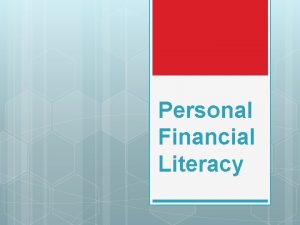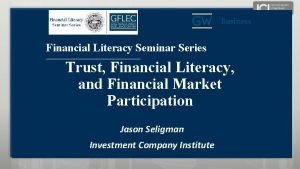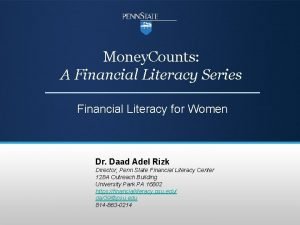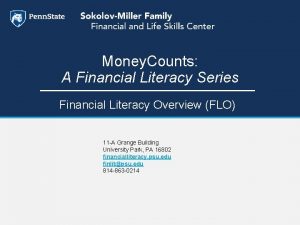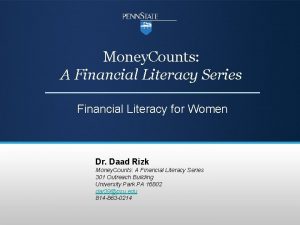FINANCIAL LITERACY Financial literacy is defined as the









- Slides: 9

FINANCIAL LITERACY

Financial literacy is defined as the ability to read, analyze, manage and communicate about the personal financial conditions that affect material well being. It includes the ability to discern financial choices, discuss money and financial issues without (or despite) discomfort, plan for the future and respond competently to life events that affect every day financial decisions, including events in the general economy. –Report of the NASBE Commission on Financial and Investor Literacy

Financial Responsibility/Decision Making In the US economy, personal financial decisions rest with the individual. Making responsible decisions related to goals for lifestyle and financial wants, fosters financial success and security. 1. Financial responsibility entails being accountable for managing money in order to satisfy one’s current and future economic choices. 2. Financial responsibility involves life long decision making strategies which include consideration of alternatives and consequences.

Income and Careers Career choices impact earning potential. Many factors, including a sound work ethic, educational level, skills and experiences, affect gross income. Decisions related to benefits, deductions, retirement, investments, etc. affect net income. 3. Competencies (knowledge and skills), commitment (motivation and enthusiasm), training, work ethic, abilities and attitude are all factors impacting one’s earning potential. 4. Income sources include job earnings and benefits, business earnings, saving and investment earnings, government payments, grants, inheritances, etc. 5. Taxes, retirement, insurance, employment benefits, and both voluntary and involuntary deductions impact take home pay.

Planning & Money Management A disciplined personal financial plan is a critical component for financial success. Financial institutions and professionals provide services, expertise and guidance in developing and implementing one’s financial plan. 6. Financial responsibility includes the development of a spending and savings plan (personal budget). 7. Financial literacy includes a decision making strategy on purchasing. 8. Financial institutions offer a variety of products and services to address financial responsibility. 9. Financial experts provide guidance and advice on a wide variety of financial issues. 10. Planning for and paying local, state and federal taxes is a financial responsibility.

Consumerism Informed purchasing decisions are essential for responsible financial management. Limited protections against some consumer fraud exist in government regulatory agencies and laws. Ultimately, consumers must be informed and vigilant when making purchasing decisions. 11. Consumerism choices consistent with one’s financial plan including decision making strategies on purchasing. 12. Consumer advocates, organizations and regulations provide important information and help protect against potential consumer fraud. 13. Utilizing financial services and risk management tools, and interpreting and comparing consumer lending statements, terms and conditions enable one to be an informed consumer. 14. Consumer protections laws help safeguard individuals from fraud and potential loss. 15. Planned purchasing decisions factor in direct (price) and indirect costs (e. g. sales/use tax, excise tax, shipping, handling, and delivery charges, etc. ).

Investing The goal of financial management is to increase one’s net worth. Investing, through a variety of options, is one way to build wealth and increase financial security. Many factors impact investment and retirement plans, including government regulations and global economic and environmental conditions, etc. 16. Using key investing principles one can achieve the goal of increasing net worth. 17. Investment strategies must take several factors into consideration including the time horizon of the investment, the degree of diversification, the investor’s risk tolerance, how the assets are selected and allocated, product costs, fees, tax implications and the time value of money. 18. Government agencies are charged with regulating providers of financial services to help protect investors.

Credit/Debt Responsible use of credit is one tool to help achieve financial and lifestyle goals. To successfully advance through financial life stages, a consumer must create, establish and maintain credit worthiness. Disciplined consumers borrow within their means at favorable terms and responsibly repay debt. 19. Credit is a contractual agreement in which a borrower receives something of value now and agrees to repay to lender at some later date. 20. Debt is an obligation owed by one party to a second party. 21. Effectively balancing credit and debt helps one achieve some short and long term goals. 22. Financial documents and contractual obligations inform the consumer and define the terms and conditions of establishing credit and incurring debt. 23. Credit and debt affect tax obligations.

Risk Management and Insurance As individuals accumulate net worth and establish a standard of living, they assume the risk of loss of income and assets. Use of a risk management plan mitigates the potential loss of income and personal net worth and also safeguards personal identity. Risk management products and strategies change over one’s life span. 24. A risk management plan can protect consumers from the potential loss of personal and/or business assets or income. 25. Safeguards exist that help protect one’s identity. 26. Diversification of assets is one way to manage risk. 27. A comprehensive insurance plan (health, life, disability, auto, homeowners, renters, liability, etc. ) serves as a safeguard against potential loss.
 This is a collection of well-defined objects
This is a collection of well-defined objects Cyber literacy for the digital age
Cyber literacy for the digital age Venn diagram media information and technology literacy
Venn diagram media information and technology literacy Mil picture analysis
Mil picture analysis Media literacy and information literacy venn diagram
Media literacy and information literacy venn diagram Các châu lục và đại dương trên thế giới
Các châu lục và đại dương trên thế giới Các loại đột biến cấu trúc nhiễm sắc thể
Các loại đột biến cấu trúc nhiễm sắc thể Nguyên nhân của sự mỏi cơ sinh 8
Nguyên nhân của sự mỏi cơ sinh 8 Bổ thể
Bổ thể Phản ứng thế ankan
Phản ứng thế ankan










